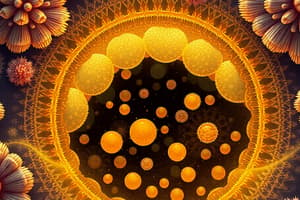Podcast
Questions and Answers
Lysosomes are membrane-bounded vesicles that arise from which of the following organelles?
Lysosomes are membrane-bounded vesicles that arise from which of the following organelles?
Golgi apparatus
The lysosome contains which type of enzymes?
The lysosome contains which type of enzymes?
Enzymes that break down large molecules into smaller molecules
What cells will be expected to contain the greatest number of lysosomes?
What cells will be expected to contain the greatest number of lysosomes?
White blood cells
What might occur in a cell lacking lysosomes?
What might occur in a cell lacking lysosomes?
What parts of the cell did hydrolytic enzymes pass through on their way to lysosomes? (Select all that apply)
What parts of the cell did hydrolytic enzymes pass through on their way to lysosomes? (Select all that apply)
What structure in plant cells stores salts, sugars, and pigments, contains enzymes that recycle and degrade molecules, and expands to exert turgor pressure?
What structure in plant cells stores salts, sugars, and pigments, contains enzymes that recycle and degrade molecules, and expands to exert turgor pressure?
What happens when a plant is watered?
What happens when a plant is watered?
Select all the structures that are found in all living cells.
Select all the structures that are found in all living cells.
Which of the cells below has the largest ratio of surface area to volume?
Which of the cells below has the largest ratio of surface area to volume?
Consider your knowledge about the cell membrane and check all of the true statements below.
Consider your knowledge about the cell membrane and check all of the true statements below.
Label the parts of the phospholipid.
Label the parts of the phospholipid.
Complete the table by dragging each structure name or description into the appropriate place.
Complete the table by dragging each structure name or description into the appropriate place.
What is one way that bacterial and archaeal cells differ from each other?
What is one way that bacterial and archaeal cells differ from each other?
Select all of the following that are true of the middle, lipid portion of the phospholipid bilayer.
Select all of the following that are true of the middle, lipid portion of the phospholipid bilayer.
Select all of the following that are true of the phospholipid bilayer.
Select all of the following that are true of the phospholipid bilayer.
Select all of the following that are found in both animal and plant cells.
Select all of the following that are found in both animal and plant cells.
Study Notes
Lysosomes
- Derived from the Golgi apparatus, lysosomes are membrane-bounded vesicles.
- Contain enzymes that break down large molecules into smaller, usable components.
- Most abundant in white blood cells due to their role in digesting engulfed pathogens.
Consequences of Lysosome Absence
- Cells lacking lysosomes cannot recycle old or worn-out parts.
- Immune functions are compromised, as bacteria digestion cannot occur.
- Synthesis of large polymers is hindered due to inability to break down precursors.
Central Vacuole in Plant Cells
- Central vacuoles store salts, sugars, and pigments and recycle/degrade molecules.
- Contribute to turgor pressure, which supports plant structure.
Plant Cell Behavior When Watered
- Watering causes the cytoplasm to dilute but results in cell shrinkage, indicating osmotic challenges.
Universal Cell Structures
- All living cells possess DNA, RNA, proteins, ribosomes, and a cell membrane, essential for functionality.
Surface Area to Volume Ratio
- Smaller cells have a larger surface area to volume ratio, optimizing nutrient intake and waste elimination.
Cell Membrane Characteristics
- Phospholipids can self-assemble and form bilayers, essential for eukaryotic cell membranes.
- Fluidity of membranes is enhanced by steroids and the fluid mosaic model describes their structure well.
Organelles and Their Functions
- Golgi Apparatus: Creates vesicles for material secretion and produces lysosomes; consists of stacked, flat sacs in both plant and animal cells.
- Ribosomes: Sites for protein synthesis made of RNA and protein, found in both cell types.
- Smooth Endoplasmic Reticulum (ER): Synthesizes lipids and detoxifies substances; consists of a single membrane network.
- Rough Endoplasmic Reticulum (ER): Produces proteins for export; covered with ribosomes.
Types of Organelles
- Lysosomes: Digest and recycle cellular waste and food components; contain digestive enzymes.
- Peroxisomes: Break down fatty acids and toxins with single-membrane sacs containing enzymes.
- Chloroplasts: Enable photosynthesis in plant cells with double membranes.
- Mitochondria: Produce energy through cellular respiration, featuring double membranes and folded inner structures.
Phospholipid Bilayer Properties
- Middle lipid portion allows passage for lipids and small nonpolar molecules and contains nonpolar fatty acid chains.
- Embedded proteins can form channels for hydrophilic substances.
Differences Between Cell Types
- Bacterial and archaeal cells differ by cell membrane compositions: bacteria contain fatty acid lipids, while archaea use nonfatty acid lipids.
Cell Domain Characteristics
- Domain Bacteria: Prokaryotic cells typically sized 1 to 10 micrometers, lacking membrane-bound organelles.
- Domain Archaea: Similar size and lack of organelles as bacteria but with unique membrane structures.
- Domain Eukarya: Larger cells (10-100 micrometers) possess a nucleus and can be single-celled or multicellular organisms.
Studying That Suits You
Use AI to generate personalized quizzes and flashcards to suit your learning preferences.
Description
Test your knowledge on cells with this quiz focused on Chapter 3 of Bio 160. Learn about lysosomes, their functions, and related cellular components. Perfect for reviewing essential concepts on cellular biology.



